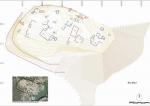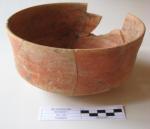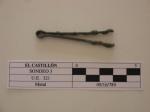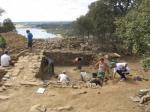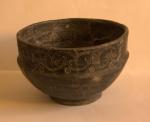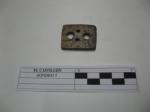Summary (English)
Research (2007-2013)
There is a 4 ha fortified settlement at this site, located on the banks of the Esla river. It is especially remarkable due to its strategic position and the presence of a sector with schematic figures on one of its shelters. During the 2007 to 2013 excavations three sectors were uncovered: an area of metallurgic activity, a housing sector and the defensive systems.
Three furnaces for the reduction of iron ore were identified in the area of metallurgic activity. The iron mineral that was processed there must have been brought from the nearby Sierra de la Culebra: more than 50 kg of slag was recorded. The furnaces have an oval-shaped layout, the walls have a stone socle and adobe roof.
As regards the defensive systems, a perimeter wall built in the 5th century surrounds the whole settlement, except in the eastern area, which has a thick rocky outcrop. Part of a second defensive wall was found in the southwest sector. It was constructed in ashlar masonry, cemented together with a thick reddish mortar.
In the housing sector, a large structure with eight chambers was documented, comprising a residential section, but also storerooms and furnaces. Worth highlighting is the presence of continuous benches and slate flooring in some of the rooms. A large amount of archaeological artifacts from the 5th century was recovered in the rooms: bronze fibulae, earrings, rings, bone buttons, a bronze osculatorium, and a large amount of potsherds, in particular stamped pottery and late Hispanic Terra Sigillata.
(translation by Laura González Fernández)
- José Carlos Sastre Blanco
Director
- José Carlos Sastre Blanco (Universidad de Granada; Asociación Científico-cultural Zamoraprotohistórica)
- Manuel Vázquez Fadón (Asociación Científico-cultural Zamoraprotohistórica)
- Patricia Fuentes Melgar (Asociación Científico-cultural Zamoraprotohistórica)
- Óscar Rodríguez Monterrubio (UNED; Asociación Científico-cultural Zamoraprotohistórica)
Team
- David Sánchez; Cristina Mateos; Gustavo González; Álvaro Mata; Alicia Tejeiro; Carlos Merino; Miguel Ángel Brezmes; Raquel Portilla; Enrique Paniagua; Raúl Catalán; Francisco J. González; Laura Cabanillas
- María Turegano
Research Body
- Universidad de Granada
Funding Body
- Asociación Científico-cultural Zamoraprotohistórica
- Caja Rural de Zamora






![Download [PDF]](/excavation/skins/fasti/images/results/download_sml.png)
